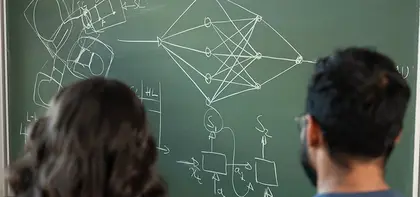
What Lie Algebras Can Tell Us About Jordan Algebras
Published Sep 28, 2023
Florio M. Ciaglia, Jürgen Jost, Lorenz Schwachhöfer
The theory initiated by Kirillov and extended by Kostant and Souriau relates algebraic structures to differential geometry and mathematical physics in a deep and very productive way. It has led to spectacular results in representation theory, classical and quantum mechanics, and it is closely related to geometric quantization. In that theory, one considers the action of a Lie algebra on its dual, the coadjoint action. Here, the Lie algebra has two roles, it is acted upon, as an algebra, and it acts because it encodes symmetries. In our contribution, we separate these two roles. We take an arbitrary algebra (and later specialize in the case of Jordan algebras - which arise naturally in quantum information theory) and let a Lie algebra act on its dual via infinitesimal symmetries. In the Kirillov-Kostant-Souriau construction, the duality between the Lie algebra and its dual turns the Lie bracket into a symplectic form. Likewise, for a general algebra, the multiplication in the algebra should be turned into a bilinear form. Of course, since the multiplication in a general algebra is not anticommutative, the resulting form will no longer be antisymmetric, that is, symplectic, but rather reflects the structure of the algebra in question.
So, let us see how far we can get with this program, what the technical obstacles are, and what additional assumptions may help us to overcome them.
Thus, we consider an algebra
Thus, from the multiplication
If we now want to carry out a Kirillov-type construction, we encounter the problem that the distribution
is, in general, not integrable. (In Kirillov's theory, the leaves of this distribution are precisely the coadjoint orbits.)
We, therefore, need a bit more structure on
(for instance, obtained by symmetrizing an associative product
Those orbits of the Lie group generated by
We also want to briefly explain what we believe is a relevant connection between this work and information geometry, both classical and quantum.
Specifically, when the Jordan algebra is that of continuous functions on a discrete and finite outcome space (the unique, up to isomorphism, finite-dimensional associative Jordan algebra), the Riemannian metric obtained with our construction turns out to be the Fisher-Rao metric tensor ubiquitous in classical information theory and statistics.
Moreover, when the Jordan algebra is that of observables of a finite-level quantum system (i.e., the algebra of self-adjoint linear operators on a finite-dimensional complex Hilbert space), the Riemannian metric tensor obtained with our construction turns out to be the Fubini-Study metric tensor on the orbit of pure quantum states, or the Bures-Helstrom metric tensor on the orbit of faithful quantum states, both of which represent possible generalizations of the Fisher-Rao metric tensor to the quantum realm.